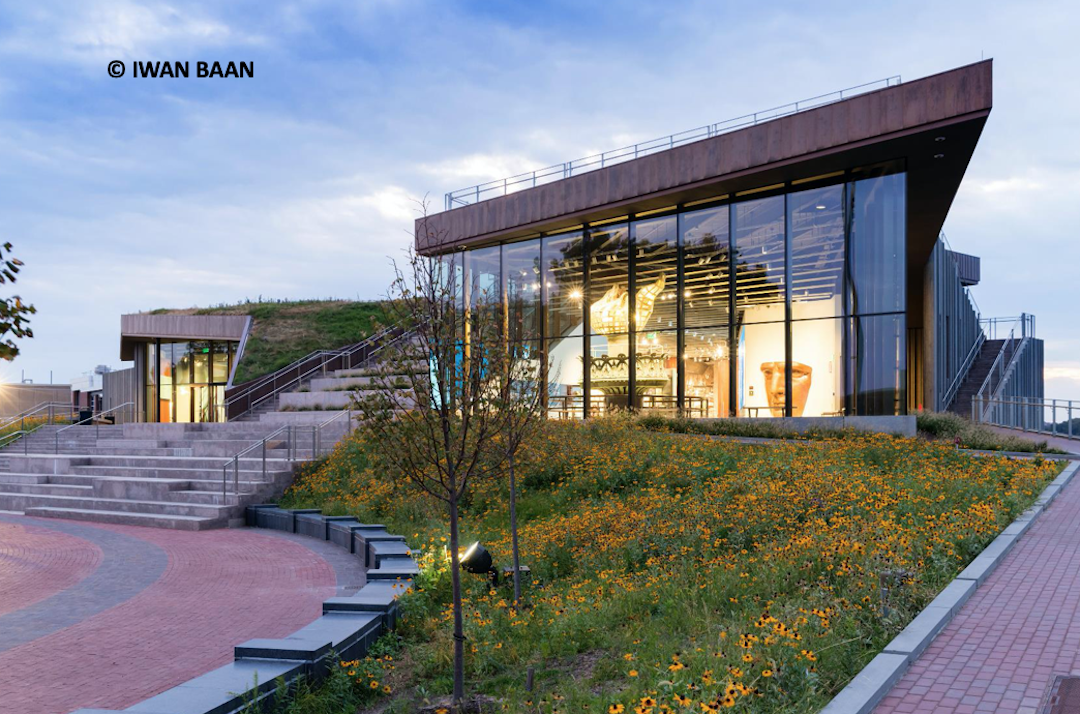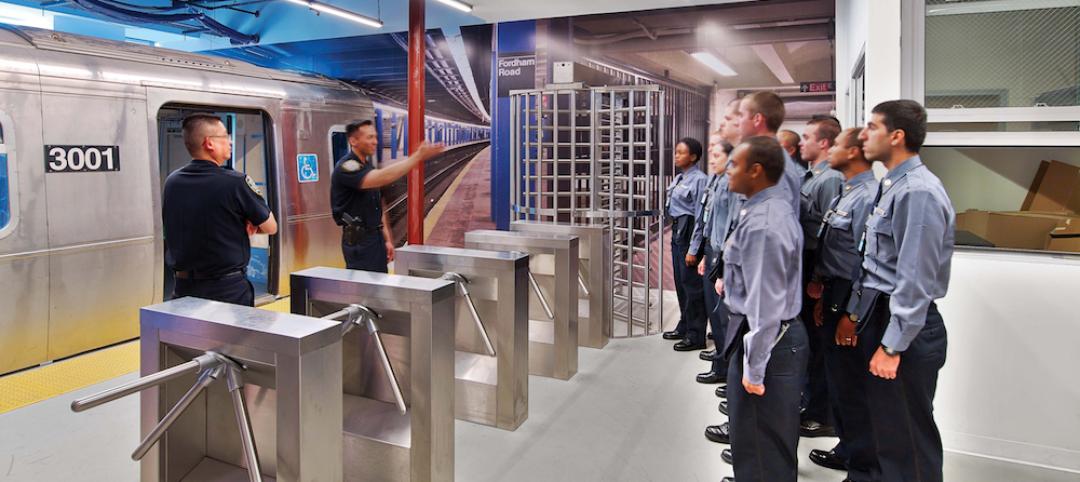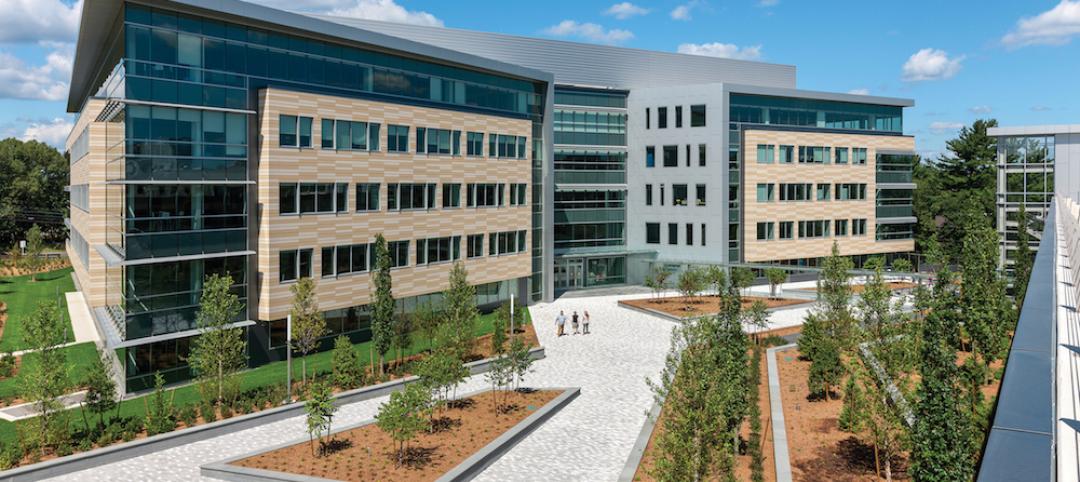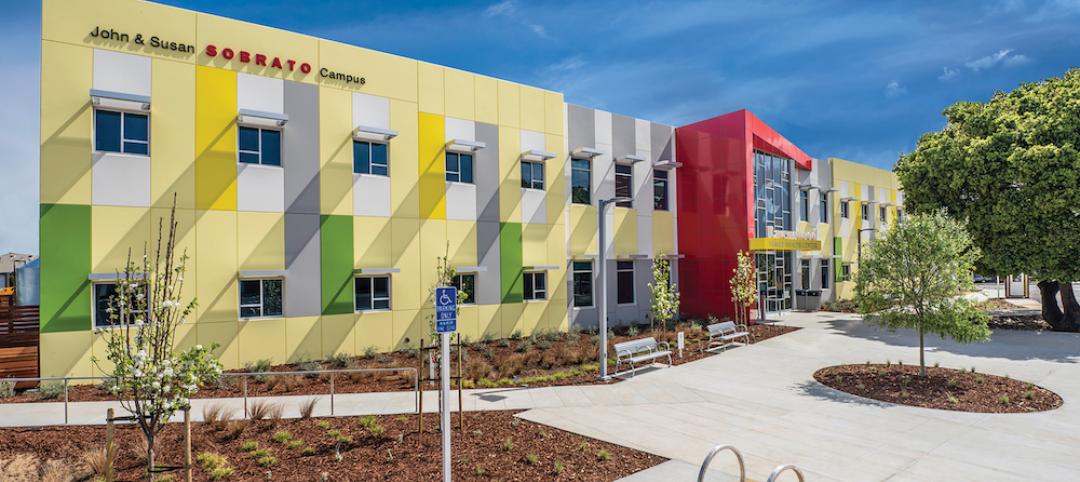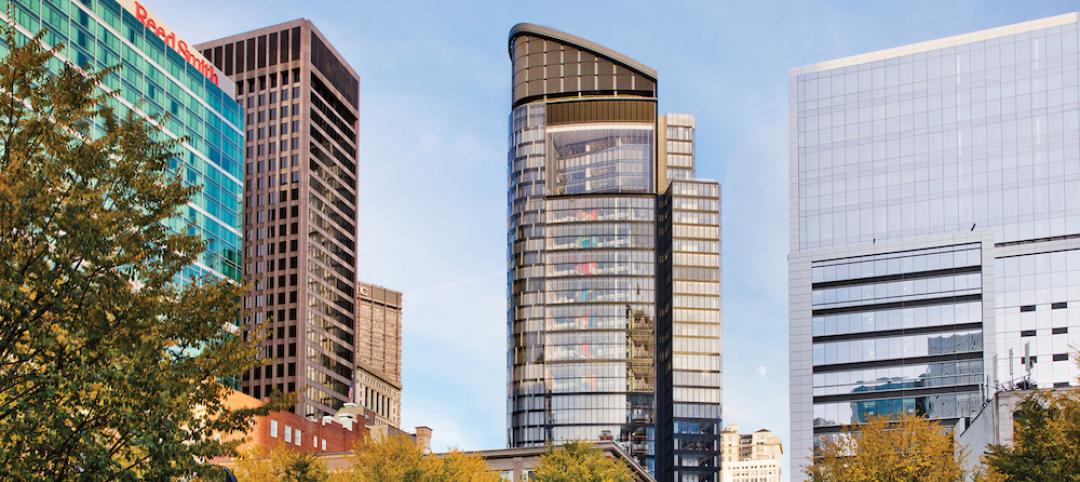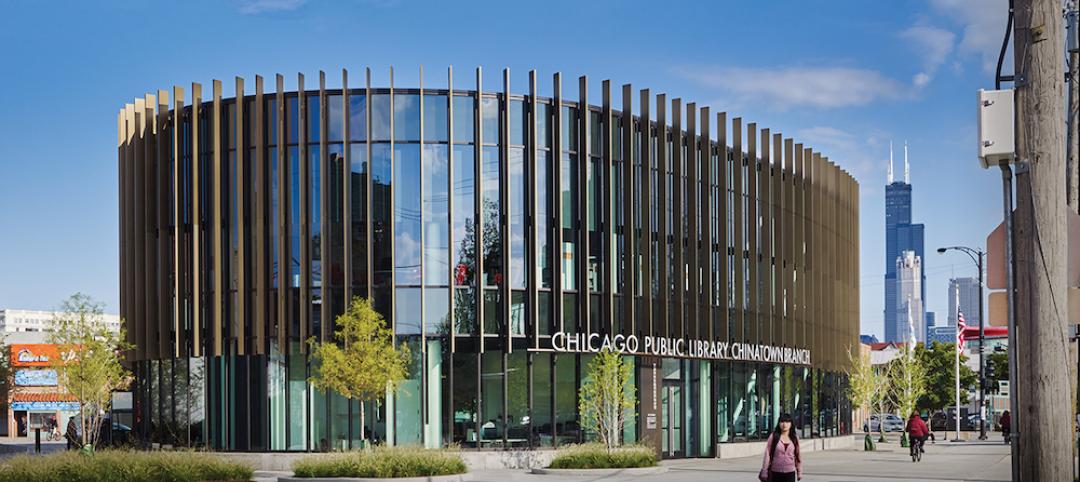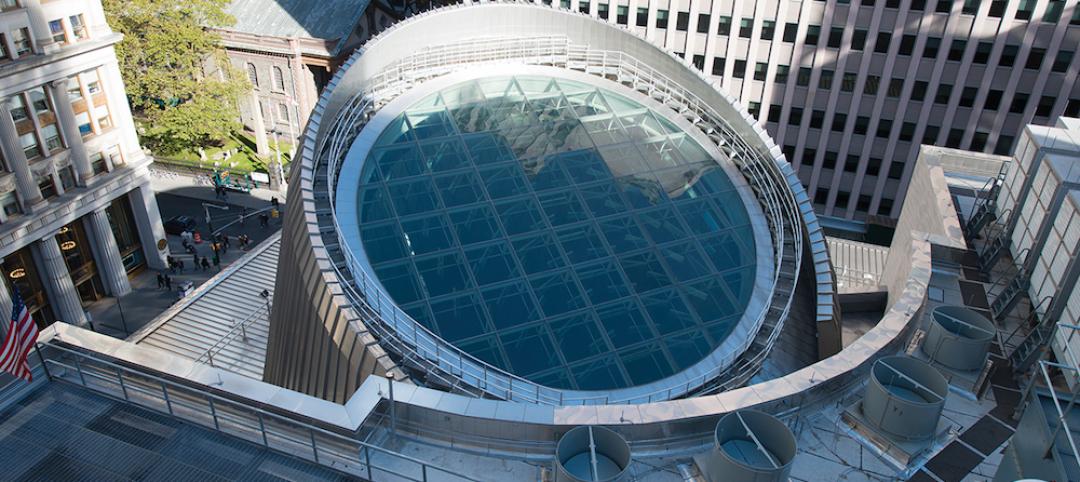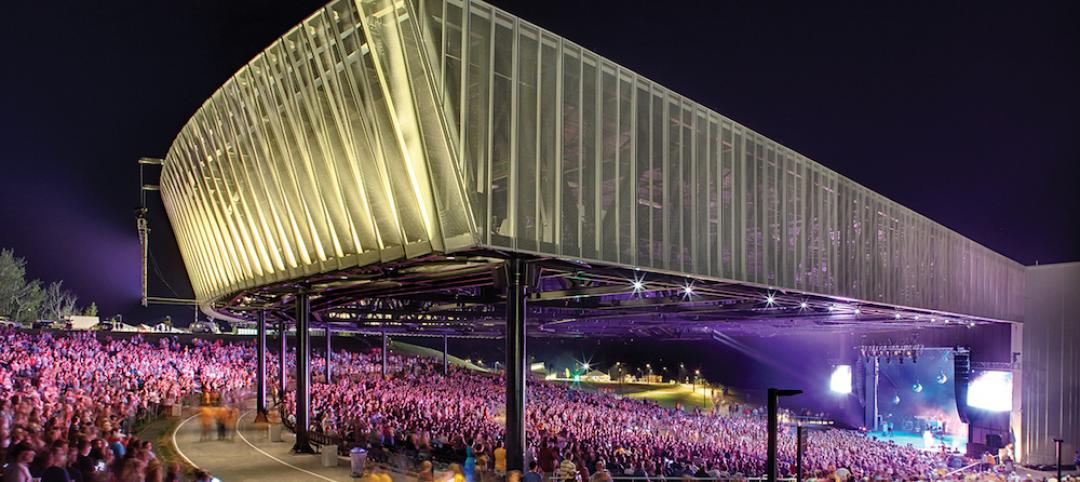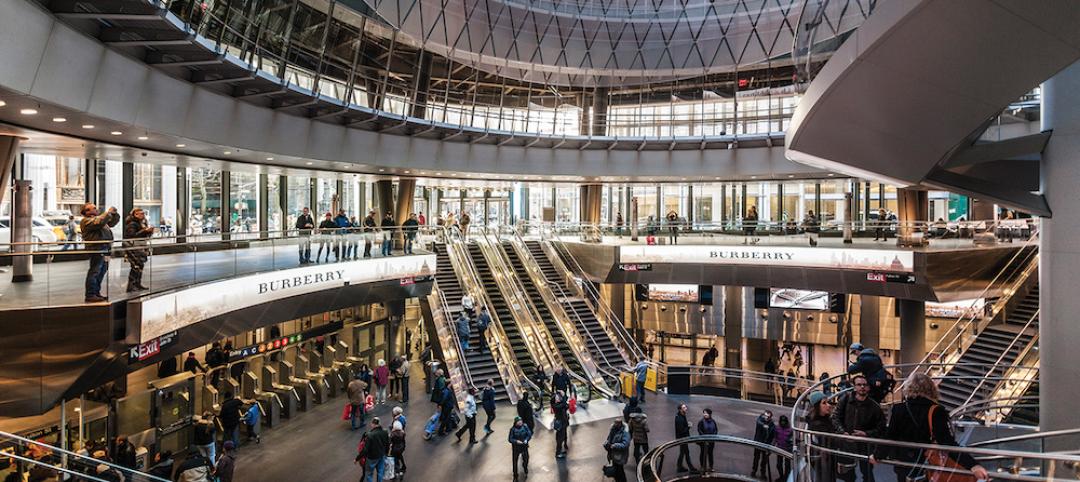After September 11, 2001, the Statue of Liberty Museum, which was then located in the statue’s pedestal, was closed to 80% of visitors due to security restrictions. Those restrictions ended on May 16 with the opening of the new Statue of Liberty Museum, which gives every visitor the opportunity to experience the story of “Liberty Enlightening the World.”
The project team, led by architecture firm FXCollaborative, had two chief goals: 1) to create a building that uplifts the experience of Liberty Island for all visitors and 2) to add to the island’s open space. To accomplish these goals, over $100 million in private funds was raised, largely from corporations and philanthropies. An online crowdfunding campaign raised $80,000 from 1,300 individuals. No government funds were used in the museum’s construction.
The museum’s location was eventually decided at the opposite end from Lady Liberty herself, where it responds to the island’s formal, axial plan established by the NPS in 1939. The site is adjacent to the circular flag plaza created during the statue’s restoration in 1986.


Liberty Island is federally owned land in New York Harbor; it is managed by the National Park Service (NPS). The 12.7-acre site, a New York City Landmark, is part of the Statue of Liberty National Monument and is listed on the National Register of Historic Places and the New Jersey Register of Historic Places. The Statue of Liberty is a UNESCO World Heritage Site.
Located at the opposite end of the island from sculptor Frederic Auguste Bartholdi’s statue, the museum is a garden pavilion designed to welcome the island’s 4.3 million annual visitors. The museum anchors the formal pedestrian mall and main axis that connects the museum to the statue, and extends this axis via a sweeping granite staircase that leads to its roof. The visitor experience culminates in a dramatic granite roof terrace that provides unobstructed views of Lady Liberty, the Manhattan skyline, and New York Harbor.

MERGING INSIDE & OUTSIDE
FXCollaborative, exhibition designer ESI Design, and landscape architect Quennell Rothschild & Partners designed the museum to accommodate heavy year-round pedestrian traffic in a progression from the plaza to the interior, from there to the exterior, arriving finally at the 14,000-sf green roof terrace. The roof’s sloped surface features the same native meadow plantings that wrap the building. The roof required a high-quality inverted membrane roofing system used under (and protected by) the green roof.
The museum’s green roof superinsulates the building by capturing and filtering stormwater; the rain garden and infiltration trenches maximize on-site percolation while collecting additional runoff. Native meadow grasses create a natural habitat for wildlife and migrating birds. Glass surfaces are low-iron, non-reflective, and feature a silk-screened dot pattern to ensure the safety of migrating birds
Working with ecologists and green roof experts, FXCollaborative and landscape architect Quennell Rothschild & Partners researched native plants and created four customized seed mixes for different planting areas for the roof, at-grade meadow, shaded meadow, and rain garden. Native salt- and wind-tolerant trees, shrubs, and perennials preserve the local ecosystem and ensure long-term sustainability.

The building responds to the layout of the island, which is based on French formal garden traditions, and establishes a naturalized landscape that is “lifted” above the formal mall. Its steps, terraces, and roof extend the park and the perimeter esplanade above the ground plane to carry visitors onto the site, creating a new visitor environment.
The new museum offers visitors an engaging sense of Lady Liberty’s story regardless of the weather. To recreate the experience of the statue’s interior, the museum features an immersive film that spans three connected theater spaces with curving walls and a stunning flythrough sequence that goes from pedestal to crown. The interior exhibit culminates in the Inspiration Gallery and the restored, original torch that graced the Statue of Liberty for nearly 100 years.
On the exterior, materials chosen in coordination with the client further tell the story of the Statue of Liberty by linking the future of Liberty Island with its past. The museum’s steps and terrace employ the same Stony Creek granite chosen for the statue’s base. Its fascia is a bronze alloy whose patina matches the monumental bronze doors of Fort Wood, the star-shaped structure that surrounds the statue. Copper fascia panels are 3/64-inch thick and made from the same type of recycled copper used for Lady Liberty’s 1986 restoration.

The museum's centerpiece is the original torch that graced the Statue of Liberty for nearly 100 years. The torch is framed in a sparkling glass vitrine that makes it visible to visitors on the island and all over New York Harbor. The 22-foot-high glass walls have a silk-screened dot pattern to deter bird impacts.

STRUCTURAL & CONSTRUCTION EXCELLENCE
Cast-in-place concrete comprises the primary floor slab and frames its plaza, stairs, and ramps. The façade is made of precast concrete panels, which double as shear walls. Steel framing supports the faceted slopes of the green roof and terrace.

All construction materials had to be delivered by boat to a temporary dock. About 5,000 cubic feet of sustainably produced granite was quarried in Connecticut for the museum’s construction. The granite is NSC 373 Gold certified, a rating system by the National Stone Institute that measures the extent to which natural stone is produced sustainably. Materials were selected for their ability to withstand high visitor traffic and the harsh, windswept, maritime setting. The building’s precast concrete exterior walls are vertically striated in reference to the nearby Palisades rising from the Hudson and were manufactured off-site. Pedestrian and seating surfaces are finished in the same grey-pink Stony Creek granite used by Richard Morris Hunt for the statue’s pedestal over 130 years ago.

The irregularly shaped site consists largely of fill material that was dumped there in the 19th century. The museum is constructed from concrete and steel, supported by steel piles driven into bedrock below the island, and concrete pile caps that transfer the weight of the museum from foundation walls to the steel piles.
REINVIGORATING THE SPIRIT OF LIBERTY
The Statue of Liberty Museum, the single biggest addition to Liberty Island since the erection of statue itself in 1876, conveys the inspiring message of Lady Liberty to a new generation of visitors.

THE LATEST IN ADA COMPLIANCE
The Statue of Liberty Museum is one of the first institutions of its kind to incorporate the 2018 updated and standardized digital accessibility requirements of the Rehabilitation Act of 1973. This update requires all federal institutions and museums to make information technology and interactive experiences accessible to all, including hearing and visually impaired visitors. Since the mandate was issued midway through the design of the museum, exhibits consultant ESI Design had to rethink wireframes, content descriptions, and the design of physical exhibits. As a result, the new museum hosts one of the most accessible such exhibits in the world.

HIGH-PERFORMANCE SUSTAINABILITY & RESILIENCY MEASURES
The museum is designed to withstand hurricane-force winds of the kind that Hurricane Sandy bestowed on Liberty Island in 2012. The primary floor slab is elevated above the 500-year flood plain (10 feet above the adjacent plaza); 84 rectangular cut-outs allow floodwaters to flow freely into the space below, reducing the risk of pressure on the structure during extreme weather events.
Thanks to such features as highly insulated walls, extensive thermal bridge mitigation, radiant floor heating, demand-control ventilation, high-efficiency lighting, and low-flow plumbing fixtures, the museum achieved LEED Gold certification under LEED BD+C: New Construction v3—LEED 2009, surpassing the National Park Service’s minimum of LEED Silver.

BTA JUDGES' COMMENTS ON THE STATUE OF LIBERTY MUSEUM
“A tastefully designed museum that deftly integrates resilient architecture with sustainable, landscape, and exhibit design,” said Justin Crane, AIA, Associate Principal, C7a - Cambridge Seven Associates, Inc. “Many environmental and ecological design excellence components,” said Chris Cerino, PE, SECB, F.SEI, New York Structural Engineering Director, STV Inc. CJ Harvey, LEED AP, Director of Operations, Haselden Construction, noted the museum’s incorporation of the new institutional ADA requirement into the design and the extensive floodwater mitigation; “They also exceeded the Park Service’s LEED request.” Said Angela Templin, CCP, BCxP, LEED AP BD+C, Northern Region Cx Manager & Commissioning Authority, GLUMAC, “The blending of the building into the landscape mixed with the views of the harbor it gives to visitors is amazing, not to mention the environmental challenges of its location near the water.”

PROJECT BUILDING TEAM & STATISTICS
BUILDING TEAM – Submitting firm/Architect FXCollaborative Owner The Statue of Liberty–Ellis Island Foundation Structural Engineer DeSimone Consulting Engineers MEP Engineer Kohler Ronan Consulting Engineers Experience/Exhibition Designer ESI Design, An NBBJ Studio Landscape architect Quennell Rothschild & Partners Program manager SBI Consultants Construction Manager Phelps Construction Group
GENERAL INFORMATION – Size 26,000 gsf Construction cost $70 million Construction time October 2016 to May 2019 Delivery method Design-bid-build
Related Stories
Building Team Awards | May 27, 2016
Big police academy trains thousands of New York's finest
The Police Training Academy in Queens, N.Y., consists of a 480,000-sf academic/administration building and a 240,000-sf physical training facility, linked by an aerial pedestrian bridge.
Building Team Awards | May 26, 2016
Cimpress office complex built during historically brutal Massachusetts winter
Lean construction techniques were used to build 275 Wyman Street during a winter that brought more than 100 inches of snow to suburban Boston.
Building Team Awards | May 25, 2016
New health center campus provides affordable care for thousands of Northern Californians
The 38,000-sf, two-level John & Susan Sobrato Campus in Palo Alto is expected to serve 25,000 patients a year by the end of the decade.
Building Team Awards | May 24, 2016
Los Angeles bus depot squeezes the most from a tight site
The Building Team for the MTA Division 13 Bus Operations and Maintenance Facility fit 12 acres’ worth of programming in a multi-level structure on a 4.8-acre site.
Building Team Awards | May 23, 2016
'Greenest ballpark' proves a winner for St. Paul Saints
Solar arrays, a public art courtyard, and a picnic-friendly “park within a park" make the 7,210-seat CHS Field the first ballpark to meet Minnesota sustainable building standards.
Building Team Awards | May 20, 2016
Pittsburgh's Tower at PNC Plaza raises the bar on high-rise greenness
The Building Team designed the 800,000-sf tower to use 50% less energy than a comparable building. A 1,200-sf mockup allowed the team to test for efficiency, functionality, and potential impact on the building’s occupants.
Building Team Awards | May 19, 2016
Chinatown library unites and serves two emerging Chicago neighborhoods
The 16,000-sf, pebble-shaped Chinatown Branch Library was built at the intersection of new and old Chinatown neighborhoods. The goal is for the building to unite the communities and serve as a catalyst for the developing area.
Building Team Awards | May 19, 2016
NYC subway station lights the way for 300,000 riders a day
Fulton Center, which handles 85% of the riders coming to Lower Manhattan, is like no other station in the city’s vast underground transit web—and that’s a good thing.
Building Team Awards | May 16, 2016
Upstate New York performing arts center revives once-toxic lakefront site
Early coordination, prefabrication, and judicious value engineering contributed to the accelerated completion of the Onondaga Lakeview Ampitheater, a Upstate New York design-build project.
Building Team Awards | May 16, 2016
12 building projects that represent the best in AEC team collaboration
A busy, light-filled Manhattan subway station and a pebble-shaped Chicago library are among the winners of the 19th annual Building Team Awards.


